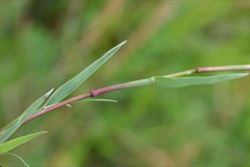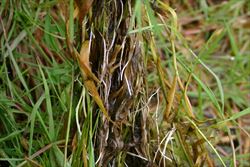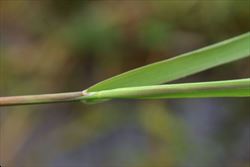Click on images to enlarge

dense infestation in a swampy area (Photo: Trevor James)

habit in flower (Photo: Trevor James)

habit of creeping stems (Photo: Trevor James)

close-up of a creeping stem (Photo: Trevor James)

the creeping stems readily produce roots at their joints (Photo: Trevor James)

close-up of stem and base of the leaf blade (Photo: Trevor James)

seed-head (Photo: Trevor James)

close-up of seeds (Photo: Steve Hurst at USDA PLANTS Database)
Scientific Name
Agrostis stolonifera L.
Family
Gramineae (South Australia)Poaceae (Queensland, New South Wales, the ACT, Victoria, Tasmania, Western Australia and the Northern Territory)
Common Names
carpet bentgrass, creeping bent, creeping bent grass, creeping bentgrass, fiorin, marsh bent, redtop, redtop bent, redtop bentgrass, seaside bent, seaside bentgrass, spreading bent
Origin
Native to north-western Africa, the Madeira Islands, Europe, western Asia, the Indian sub-continent, Mongolia and eastern Russia.
Naturalised Distribution
Widely naturalised in the temperate regions of Australia. It is common in the coastal and sub-coastal districts of southern and central New South Wales, in Victoria, in Tasmania, in south-eastern South Australia and in the coastal districts of south-western Western Australia. Also sparingly naturalised in the ACT and in the cooler parts of south-eastern Queensland.
Also widely naturalised in other parts of the world, including New Zealand and Hawaii, and questionably native to parts of North America.
Notes
Creeping bent (Agrostis stolonifera) is regarded as an environmental weed in New South Wales, Victoria and Tasmania. This species is commonly cultivated as a lawn grass in southern Australia, and is often also used in golf and bowling greens. It has become a weed of pastures, roadsides, disturbed sites, waste areas and damp or semi-aquatic natural habitats (i.e. seasonal freshwater wetlands, riparian areas, marshes, coastal scrub and beaches). Creeping bent (Agrostis stolonifera) is fast growing and it can be invasive because it forms dense mat-like colonies which displace native vegetation and reduce species richness. These colonies are formed by the growth of its creeping aboveground stems (i.e. stolons), which easily take root and develop into new plants if they become separated from the rest of the colony.
This species is regarded as a very serious threat to one or more vegetation formations in Victoria. For example, it is listed as a "high threat" weed species in floodplain riparian woodlands, estuarine wetlands and sedgy swamp woodlands. It is also a weed of peatlands, wetlands, swamps and spring soaks in the highland areas of this state. Creeping bent (Agrostis stolonifera) has been recorded in conservation areas in Victoria (e.g. Organ Pipes National Park, Phillip Island Nature Park, Finns Reserve, Lysterfield Lake Park and Churchill National Park) and is also listed as an environmental weed in the Goulburn Broken Catchment.
In New South Wales, creeping bent (Agrostis stolonifera) is listed as an environmental weed in Blue Mountains City Council area. It has also been recorded in the Greens Beach/Kelso Coastal Reserve in Tasmania.

